Related Research Articles

The New York City Subway is a rapid transit system owned by the City of New York and leased to the New York City Transit Authority, a subsidiary agency of the state-run Metropolitan Transportation Authority (MTA). Opened in 1904, the New York City Subway is one of the world's oldest public transit systems, one of the most-used, and the one with the most stations. The New York City Subway is the largest rapid transit system in the world by number of stations, with 472 stations in operation. Stations are located throughout the boroughs of Manhattan, Brooklyn, Queens, and the Bronx.
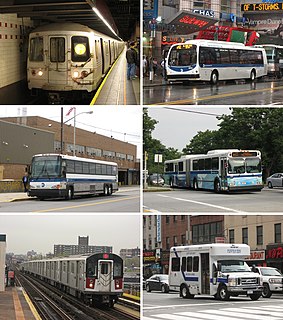
The New York City Transit Authority is a public authority in the U.S. state of New York that operates public transportation in New York City. Part of the Metropolitan Transportation Authority, the busiest and largest transit system in North America, the NYCTA has a daily ridership of 8 million trips.

The Rockaway Park Shuttle is a New York City Subway shuttle train that operates in Queens. It connects with the A train at Broad Channel station and is the latest iteration of the Rockaway Shuttle services that have been running on the Rockaway peninsula since 1956. This shuttle train provides service to the western part of the peninsula, with a terminus at Rockaway Park–Beach 116th Street. The fully above-ground route operates on trackage that was originally part of the Long Island Rail Road's Far Rockaway Branch until the mid-1950s. During summer weekends, to eliminate an additional transfer and thus ease beach access, the Rockaway Park Shuttle is typically extended four stations north to Rockaway Boulevard, the southernmost station shared by Rockaway-bound and Lefferts Boulevard-bound A trains.
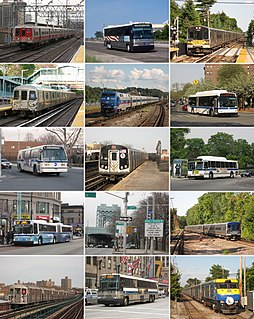
The Metropolitan Transportation Authority (MTA) is a public benefit corporation responsible for public transportation in the U.S. state of New York. The MTA is the largest public transit authority in the United States, serving 12 counties in Downstate New York, along with two counties in southwestern Connecticut under contract to the Connecticut Department of Transportation, carrying over 11 million passengers on an average weekday systemwide, and over 850,000 vehicles on its seven toll bridges and two tunnels per weekday.

Wall Street is a station on the IRT Lexington Avenue Line of the New York City Subway, located at the intersection of Broadway and Wall Street. It is served by the 4 train at all times and the 5 train at all times except late nights.

81st Street–Museum of Natural History is a local station on the IND Eighth Avenue Line of the New York City Subway. It is served by the B on weekdays, the C train at all times except nights, and the A train during late nights only.
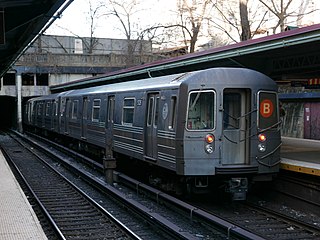
The B Sixth Avenue Express is a rapid transit service in the B Division of the New York City Subway. Its route emblem, or "bullet", is colored orange, since it uses the IND Sixth Avenue Line in Manhattan.
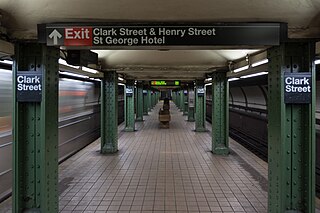
Clark Street is a station on the IRT Broadway–Seventh Avenue Line of the New York City Subway. It is located at Clark Street and Henry Street in Brooklyn Heights, Brooklyn. It is served by the 2 train at all times and the 3 train at all times except late nights.
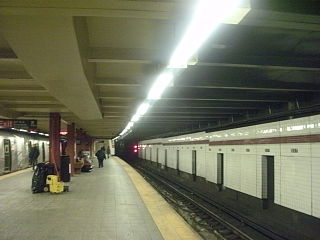
Inwood–207th Street is the northern terminal station of the IND Eighth Avenue Line of the New York City Subway. Located at the intersection of 207th Street and Broadway in the Manhattan neighborhood of Inwood, near Inwood Hill Park, it is served by the A train at all times.

36th Street is an express station on the BMT Fourth Avenue Line of the New York City Subway, located at 36th Street and Fourth Avenue in Sunset Park, Brooklyn. It is served by the D, N and R trains at all times, as well as several W trains during rush hours.
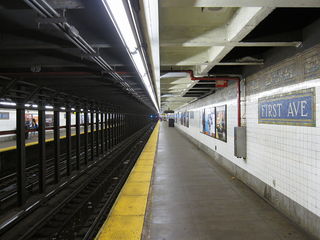
First Avenue is a station on the BMT Canarsie Line of the New York City Subway. Located at the intersection of First Avenue and East 14th Street at the border of Stuyvesant Park, Stuyvesant Town, and the East Village in Manhattan, it is served by the L train at all times.

59th Street–Columbus Circle is a New York City Subway station complex shared by the IRT Broadway–Seventh Avenue Line and the IND Eighth Avenue Line. It is the eighth-busiest station complex in the system. It is located at Columbus Circle in Manhattan, where 59th Street, Broadway and Eighth Avenue intersect, and serves Central Park, the Upper West Side, Hell's Kitchen, and Midtown Manhattan. The station is served by the:
John Tauranac writes on New York City history and architecture, teaches the subject and gives tours of the city, and designs city maps and transit maps.

175th Street is a station on the IND Eighth Avenue Line of the New York City Subway. Located in the Washington Heights neighborhood in Upper Manhattan, at the intersection of 175th Street and Fort Washington Avenue, it is served by the A train at all times.
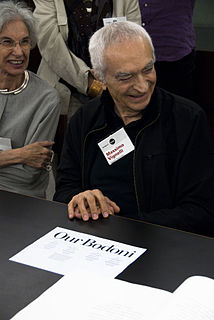
Massimo Vignelli was an Italian designer who worked in a number of areas ranging from package design through houseware design and furniture design to public signage and showroom design. He was the co-founder of Vignelli Associates, with his wife, Lella. His ethos was, "If you can design one thing, you can design everything," and this was reflected in the broad range of his work.

Fifth Avenue/53rd Street is a station on the IND Queens Boulevard Line of the New York City Subway. Located at the intersection of Fifth Avenue and 53rd Street in Manhattan, it is served by the E train at all times and the M train weekdays except late nights.

Alabama Avenue is an elevated station on the BMT Jamaica Line of the New York City Subway. Located at the intersection of Alabama Avenue and Fulton Street in East New York, Brooklyn, it is served by the J train at all times and the Z train during rush hours in the peak direction.
Bob Noorda was a Dutch-born Italian graphic designer who lived and worked primarily in Milan from 1954 until his death. Steven Heller, in his The New York Times obituary of Noorda, called him "an internationally known graphic designer who helped introduce a Modernist look to advertising posters, corporate logos and, in the 1960s, the entire New York City subway system."

Lella Vignelli was an Italian designer who was the founder of Vignelli Associates. She had "a lifelong collaborative working relationship" with her husband, Massimo Vignelli. She was known to be the business arm of Vignelli Associates and she played a key role in the success of the design firm.
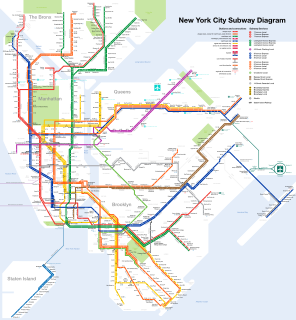
Many transit maps for the New York City Subway have been designed since the subway's inception in 1904. Because the subway was originally built by three separate companies, an official map for all subway lines was not created until 1940, when the three companies were consolidated under a single operator. Since then, the official map has undergone several complete revisions, with intervening periods of comparative stability.
References
- ↑ Hogarty, Dave (August 3, 2007). "Michael Hertz, Designer of the NYC Subway Map". Gothamist . Archived from the original on August 18, 2009. Retrieved September 26, 2018.
- ↑ Genzlinger, Neil (February 25, 2020). "Michael Hertz — You've Surely Seen His Subway Map — Dies at 87". The New York Times . Retrieved February 25, 2020.
- ↑ Rawsthorn, Alice (August 5, 2012). "The Subway Map That Rattled New Yorkers". The New York Times. Retrieved September 26, 2018.
- ↑ Haberman, Clyde (December 14, 2009). "No W or Z? Mapmakers, Grab Your Pens". The New York Times. Retrieved September 26, 2018.